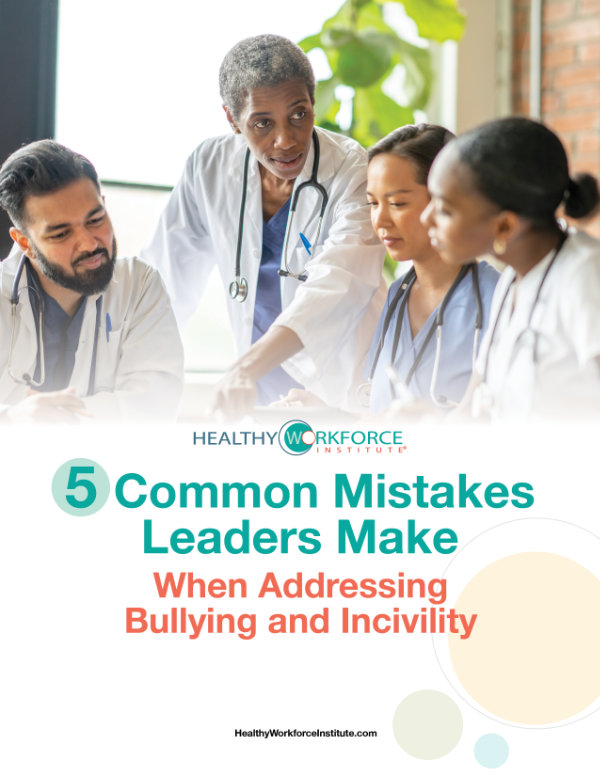
Did you know that from 2002 to 2013, incidents of serious workplace violence were approximately four times more common in healthcare than in private industry?
In 2013, according to the United States Bureau of Labor Statistics, psychiatric aides experienced the highest rate of violent injuries. A 2014 survey conducted by the Joint Commission on hospital crime reported 75 percent of aggravated assaults and 93 percent of all assaults against healthcare workers were from patients or customers. And recently, the Joint Commission released a Sentinel Alert requiring all healthcare organizations to address the rising incidents of verbal and physical aggression in healthcare.
Workplace violence is alive, it’s doing well, and it’s on the rise!
The American Nurses Association Health Risk Appraisal Survey of registered nurses and nursing students found that 25% had been physically assaulted at work by a patient or patient’s family member. As we just celebrated National Nurses’ Week, rather than focusing on gimmicks and cookies, let’s express appreciation by implementing and enforcing policies and protocols to prevent verbal and physical attacks against the very nurses we honor.
What is workplace violence?
The U.S. Department of Labor defines workplace violence as “An action (verbal, written, or physical aggression), which is intended to control or cause, or is capable of causing, death or serious bodily injury to oneself or others, or damage to property”.
In a report from 2016, OSHA listed factors contributing to assaults on nursing staff, including patient history (substance abuse or aggression), individual staff behaviors, (working alone with a patient), environmental flaws or dangers, (poor lighting and unit design), as well as organizational malfunctions (poor communication, inadequate staffing, lack of management commitment, high turnover, and “lack of facility policies and staff training for recognizing and managing escalating hostile and assaulting behaviors from patients, clients, visitors, or staff”).
You may be thinking, “This happens all the time—what’s the big deal?”
The American Nurses Association official position statement on workplace violence has declared “the nursing profession will no longer tolerate violence of any kind from any source”. Just last month (April 2018), the California Nurses Association succeeded in pushing through legislation that mandated hospitals and skilled nursing facilities to “assess and identify areas in which employees are vulnerable to violence”. In addition, the law outlined the specific education and training to be provided to hospital staff, including “how to recognize potentially violent situations, strategies to avoid physical harm, how to report violent incidents to the employer, and any resources available to employees for coping with violence like critical incident stress debriefing or employee assistance programs”.
Violence against nurses IS A BIG DEAL!!
A patient on a behavioral health unit approaches a patient care technician at midnight requesting hot tea. The tech explains that she can’t give him hot tea, because he has already received medication for sleep and unit rules prohibit patients from removing food from the dining area. The patient begins to yell and curse at the tech. The technician refers the patient to the nurse. As the tech turns to walk away, the patient becomes enraged, grabs the tech by her ponytail, and punches her in the jaw.
Could this assault have been prevented? If so, how?
At the Individual Level
Workplace violence prevention starts with YOU! Front-line nurses think: Safety first, communication, and consistency. In general, start with yourself and move from inner self to outer environment. Monitor your own response to the situation and continuously scan the environment for hazards and resources at your disposal.
At the Unit Level
The layout and design of the unit should provide for the safety of nursing staff and patients with easy access to exits and help. Adequate staffing should be a top priority, with back-up plans for call-offs, inclement weather, or disasters. Wait times should be minimized, while visitors and patients should be kept abreast of unit routines, patient interventions, treatments, and other pertinent information. Staff should assess and anticipate patient needs and behaviors in regular rounds. Unit policies should be clearly defined and consistently implemented by staff for the safety of patients, visitors, and staff.
What Else Can We Do?
Think teamwork! Staff should work in pairs or teams, remaining together throughout incidents of escalation and aggression, until the agitated person no longer poses a threat. A united front is more effective than a single nurse trying to reason with an agitated person. Encourage all staff to maintain low voice volume and pitch and to avoid power struggles. Practice the tap-out policy, in which a fellow team member taps the shoulder of the nurse struggling with an escalating patient, the struggling nurse bows out, and the second nurse tries to calm the individual.
At the Organizational Level
Upper management can create clear safety policies and assure safe unit design, safe workflow, safe equipment, and safe staffing that is based on patient acuity. Lines of communication should remain open between front line staff and upper management. After each workplace violence situation is resolved, administrators and managers should stress regular, prompt reporting of all incidents. Policies that are not being enforced properly by unit managers should be discussed with managers, reviewed, and revised as appropriate.
Regarding management of escalating violence, a behavioral rapid response team, consisting of behavioral health experts, security guards, and the clinical supervisor can be employed to assist with such incidents anywhere in the hospital. Clinical supervisors or behavioral health experts should provide post-incident debriefings to ensure that everyone is safe and uninjured, to discuss system failures and improved strategies, and to provide immediate and ongoing emotional support to staff and others affected by the violence.
Finally, administrators and managers should maintain strong working relationships with local law enforcement and community resources for support during violent incidents and to educate the public that violence will not be tolerated by the health care team.
Nurses should not have to tolerate workplace violence, but the responsibility for prevention lies with each of us. Thanks to all of you for your sacrifice and for all you do every day!
At the Healthy Workforce Institute, we are doing our part to help healthcare organizations address physical and verbal violence in healthcare. Be sure to join our community to get the newest resources designed to help you prevent another healthcare employee from becoming a statistic.













